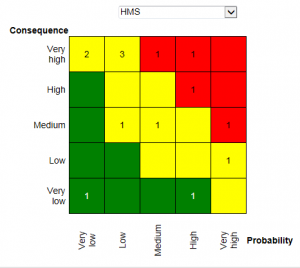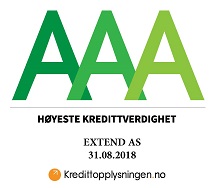Risk Management
The Risk Management module in EQS provides tools to identify, assess, evaluate, treat and monitor both hazard and opportunity risks across your organisation.
Generally, businesses have a higher risk level than they think. Making wrong decisions that cause your business to not achieve its goals can be fatal for the entire organization. Investigations carried out by Ernst & Young shows that companies that have a strong focus on risk management, also are those who are most profitable.
With EQS Risk Management you can identify potential risks, assess the likelihood of their occurrence, consider the consequences of them and prepare actions to mitigate the risks. Visualization of the risks in a risk matrix gives you an overview of all the threats. It shows you which ones are the most critical and thus the ones that should be prioritized. EQS Risk Management supports ISO 31000 and most standards in accordance with regulatory requirements for Risk Management.
Basis for good risk assessment
Through that everyone in the organization can contribute anywhere, anytime, whenever it happens, more risks will be registered and the quality work will be improved. This provides a good basis for retrieving reports and statistics, which in turn makes the system a management tool for the Management. EQS contributes to increased focus on measures and solutions, as well as highlighting risks that provide the basis for proper risk assessments.
 Get help with achieving goals through good risk assessments
Get help with achieving goals through good risk assessments
Risk management concerns everyone in the organization. All employees can help identify risk factors and help reduce the risk of them becoming deviations or accidents. Then the goals must be well known, and it must be easy to contribute to risk-reducing measures, at all levels.
Higher value and lower cost with good risk analysis
Many businesses can save costs, increase production and avoid accidents due to systematic work with security, reliability and maintenance. Good risk analysis strengthens the bottom line, and it’s not just about mapping threats, but also about gaining an overview of what potential you do not exploit.
Benefits and key features:
EQS Risk Management can provide information and trends to help you make strategic recommendations.
• Support to identify and register risks as elements of risk
• An element of risk is a description of a risk
• Each element of risk is assessed in relation to a risk area
• For the defined risk areas in the system, it is possible to put in assessment of potential events and consequence
• A registered element of risk is handled by a risk administrator, who makes further judgment of probability and consequence related to the element of risk
• Each element of risk can be linked to actions
• As corrective and preventive actions are performed, the assessment of the risk element is changed
• Elements of risks are version controlled
• A selection of risk elements can be made, and a risk profile can be visualized by a risk matrix
• Both the risk matrix and the data can be stored
• Related documents might be linked as to show the context of the risk assessment and/or the complete plans of action for identified risks
Establishing the context: Functionality which supports the work with defining the external and internal parameters to be taken into account when managing risk, and setting the scope and risk criteria (eg. use of related documents).
Risk identification: Elements of risk are found and listed.
Risk analysis: An administrator approves the risk elements, and makes an assessment of risk (probable events and potential consequence within each target area).
Risk evaluation: The elements of risk can be retrieved from the message list. From there a risk matrix can be made and saved. Links to other related documents in EQS (existing or new) can be created.
Risk treatment: Each risk element might be correlated with action, action responsible person, person to approve the action and a deadline for the project.
Visualization of risks in a risk matrix makes it easy to see all the hazards, which ones that are the most critical and thus should also be prioritized.
Order demo of EQS Quality System
Related content
Compliance
In compliance with current requirements In a time where customers demand increasingly high standards, authorities introduce new regulations, and the media closely follows, it is more important than ever to ensure that the business delivers in compliance with current requirements. EQS Compliance Through EQS Compliance, you quickly gain an overview of current requirements, and from […]
Forms and checklists
Create and design your own forms and checklists with EQS Workflow You can tailor digital tool support to several of the organization’s processes with your own forms and checklists with the form designer in EQS Workflow. Many businesses have activities and processes where registrations and processing occur via email, paper forms, or in Excel. With […]
Integration
Integrations in EQS Many businesses desire integrations between different types of systems to avoid duplicate registrations and double updates. With the EQS Integration module, you get numerous opportunities for integration through REST API, Web services, and federated searches. Also, integrations with ADFS and Azure AD are supported. EQS Integration Through this module, you gain access […]

